Once you have booked your tickets to the Acropolis, you need to know how to visit the Acropolis, considering opening hours, transportation, what to see and how, and other crucial information.
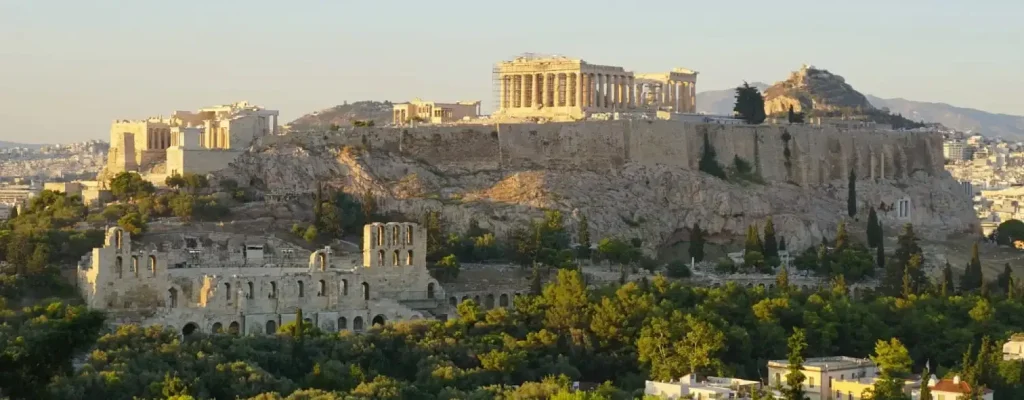
| Period | Days | Hours |
|---|---|---|
| April – August | Monday – Sunday | 08:00 am – 08:00 pm |
| September 1st – 15th | Monday – Sunday | 08:00 am – 07:30 pm |
| September 16th – 29th | Monday – Sunday | 08:00 am – 07:00 pm |
| October 2nd – 15th | Monday – Sunday | 08:00 am – 06:30 pm |
| October 16th – 31st | Monday – Sunday | 08:00 am – 06:00 pm |
| November – March | Monday – Sunday | 08:00 am – 06:00 pm |
Important notice: people who have selected the last slot of the day will be able to enter during the first 30 minutes of the selected slot.
More about the Acropolis opening hours.
The Acropolis of Athens contains several magnificent ancient monuments, each with its own historical significance and architectural marvels. While it might seem tempting to explore randomly, following a strategic route will help you appreciate the site’s full story while avoiding crowds and maximizing your photography opportunities.
This guide assumes that you start at the main western entrance and walk clockwise around the summit before descending the southern slope. This route minimizes backtracking and allows you to visit all the sites in about 2-3 hours total:
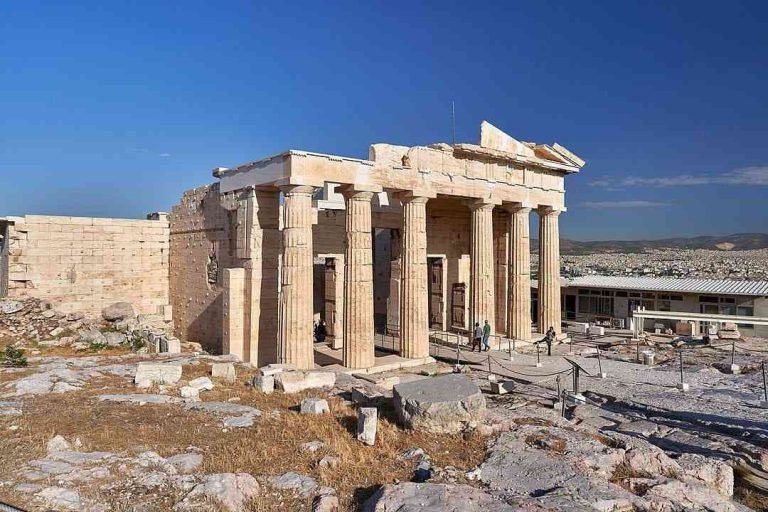
Your Acropolis journey begins at the Propylaea, the monumental gateway that served as the grand entrance to the sacred precinct. This impressive marble structure, built between 437-432 BCE, features a central hall with massive Doric columns and smaller Ionic columns in the side wings. As you pass through this ancient threshold, you’ll walk the same path that Athenian citizens took during religious festivals, and you’ll get your first breathtaking views of the Parthenon ahead.
Estimated visit time: 15-20 minutes.
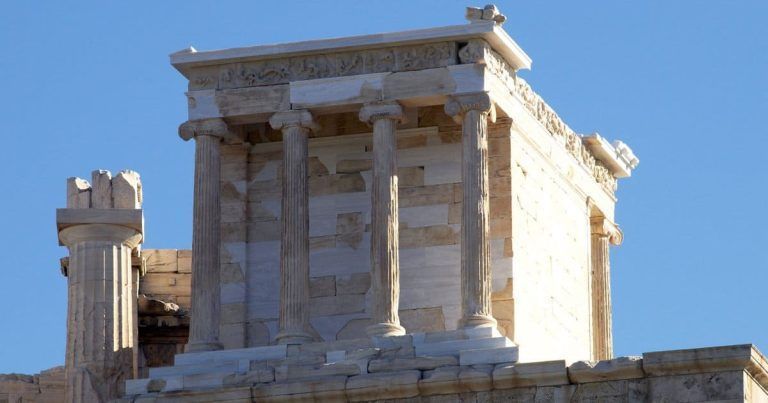
Just to your right after entering through the Propylaea, you’ll find the small but perfectly proportioned Temple of Athena Nike perched on a bastion overlooking the city. This elegant Ionic temple, dedicated to Athena as the goddess of victory, offers stunning panoramic views of Athens below. Despite its modest size, the temple’s delicate marble reliefs depicting Greek victories make it a masterpiece of classical architecture.
Estimated visit time: 10-15 minutes.
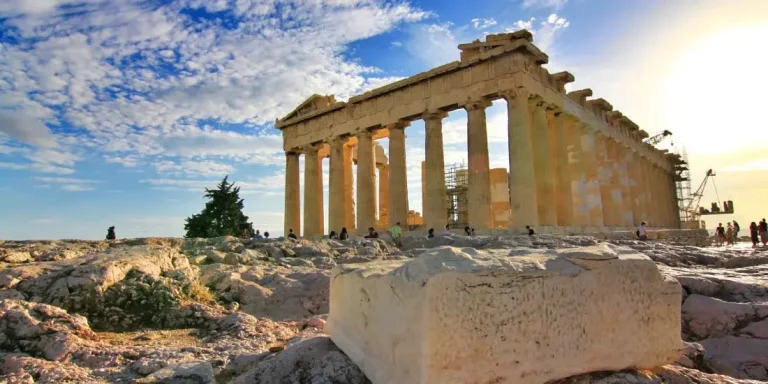
The crown jewel of the Acropolis, the Parthenon. Built between 447-438 BCE, this Doric temple dedicated to Athena Parthenos showcases the pinnacle of classical Greek architecture. While you can’t enter the interior, walking around its perimeter reveals intricate sculptural details, optical illusions in its design, and the subtle ways ancient architects achieved visual perfection.
Estimated visit time: 30-45 minutes.
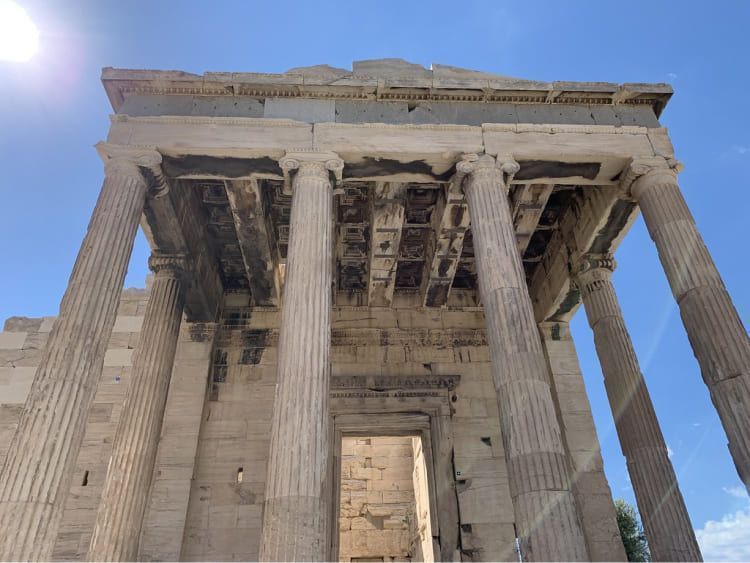
Located between the Parthenon and the Erechtheion, the foundations and scattered remains of the Old Temple of Athena tell the story of the Acropolis before the Persian destruction. Though only ruins remain of this archaic temple that once housed the original wooden statue of Athena, the site helps visitors understand the continuity of worship on this sacred hill.
Estimated visit time: 10-15 minutes.
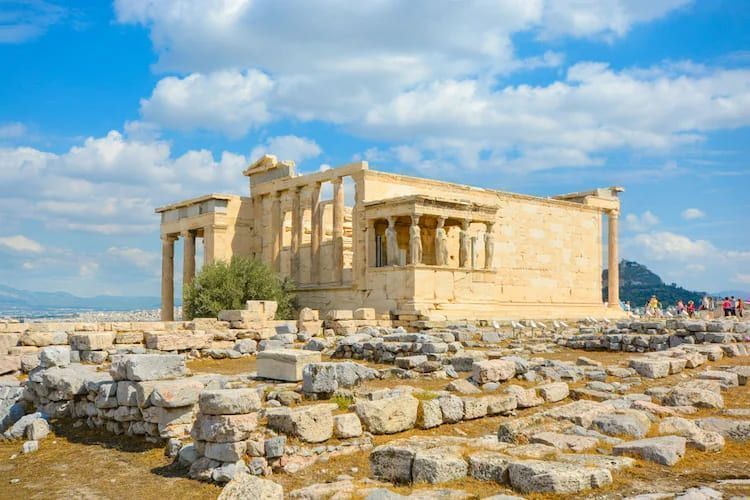
The most architecturally complex building on the Acropolis, the Erechtheion is famous for its Porch of the Caryatids, where six sculpted maidens serve as columns supporting the roof. Built on the most sacred spot of the Acropolis, this temple accommodated multiple ancient cults and the legendary contest between Athena and Poseidon for Athens’ patronage. The building’s asymmetrical design and different ground levels showcase the ingenuity of ancient architects working with challenging terrain and religious constraints.
Estimated visit time: 20-25 minutes.

Located on the southwestern slope of the Acropolis, this well-preserved Roman theater was built in 161 CE and still hosts performances today. The steep stone seating carved into the hillside could accommodate 5,000 spectators, and the restored marble seats and stage area give visitors a clear sense of ancient theatrical experiences. Even if you can’t enter during performances, viewing this impressive structure from above demonstrates how the Acropolis served cultural as well as religious purposes.
Estimated visit time: 15-20 minutes.
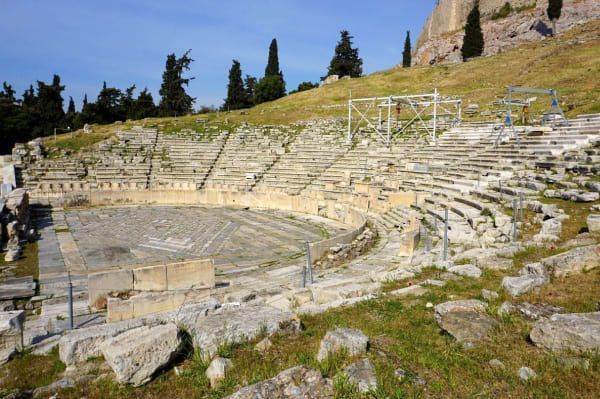
Conclude your visit at the birthplace of Greek drama, where the works of Aeschylus, Sophocles, and Euripides were first performed. Located on the southern slope, this ancient theater reveals the evolution of dramatic architecture through its various construction phases from the 5th century BCE through Roman times. The surviving marble thrones reserved for priests and officials, along with the remains of the stage and orchestra, help visitors imagine the religious festivals and dramatic competitions that shaped Western theater tradition.
Estimated visit time: 20-25 minutes.
Address: Athens 105 58, Greece
The Acropolis of Athens is located on a rocky outcrop above the city of Athens, Greece. It is situated in the central part of Athens, just a short distance from the historical district of Plaka
There are several ways to arrive at the Acropolis of Athens. One of the most convenient options is to take the Athens Metro to the Acropolis Station, which is located just a short walk from the entrance.
If you prefer to take a bus, several public bus routes have stops near the Acropolis, including routes 24, 40, and 230.
Taxis are also readily available in Athens and can drop you off at the entrance of the Acropolis. If you are driving, there are several parking options near the Acropolis, but it is recommended to park outside of the city center and take public transportation to avoid traffic and parking difficulties.
The ideal time is 8:00 AM when the site opens, offering temperatures 5-10°C cooler than midday and avoiding massive cruise ship crowds that arrive between 9-10 AM (representing 50% of daily visitors). You’ll experience pristine conditions with soft morning light illuminating the white Pentelic marble. Alternatively, the last two hours before closing provide 70% fewer crowds and spectacular golden light perfect for photography.
April-May and September-October are optimal months, featuring comfortable temperatures of 19-26°C and manageable crowds. Summer presents serious challenges with regular temperatures of 32-40°C (often exceeding 42°C), triggering automatic site closures from 1:00-5:00 PM when temperatures surpass 40°C. The Acropolis experiences intensified microclimatic conditions due to Athens’ urban heat island effect and its exposed 107-meter elevation, making conditions feel 2-5°C hotter than official temperature readings.
You can find more information here about the best time to visit the Acropolis.
Visitors with disabilities over 67% receive free entry plus one companion by presenting valid ID and Disability Certificate at ticket booths – no advance booking required for entry. However, elevator access should be reserved in advance through the official website to guarantee availability.
The modern panoramic elevator (installed December 2020) accommodates up to 18 people or two wheelchairs with companions, providing stunning views during ascent to the plateau near the Erechtheion. Concrete paths and widened routes ensure wheelchair access throughout most areas, though some ancient surfaces remain uneven and may require assistance.
Full facilities are available including accessible bathrooms at both entrance and summit, plus the nearby Acropolis Metro station (red line) offers complete elevator access. The Acropolis Museum is fully wheelchair accessible with ramps, elevators, and free wheelchair rentals, making the entire archaeological complex welcoming to visitors with mobility needs.
Use the southeast lateral entrance to avoid the heavy congestion at the main western entrance, where most tour groups and cruise passengers enter. This strategic choice can save you significant waiting time, especially during peak hours.
Book early through the official platform as morning time slots (particularly 8:00-11:00 AM) sell out first during high season. Since the mandatory reservation system limits daily capacity to 20,000 visitors, securing your preferred time slot up to 3 months in advance is essential for optimal timing and crowd avoidance.
The Acropolis is closed on major holidays: January 1st, March 25th (Greek Independence Day), May 1st (Labor Day), Easter Sunday, and December 25th-26th. Plan accordingly and check these dates when booking your visit, especially during spring when Easter dates vary each year.
Advance booking is mandatory since April 2024 through the time slot system, with maximum capacity of 20,000 daily visitors. Tuesdays and Thursdays see the smallest crowds, while weekends experience maximum congestion.
